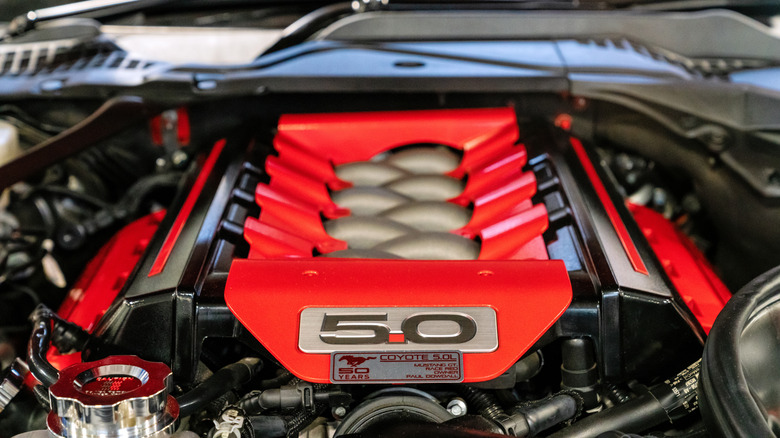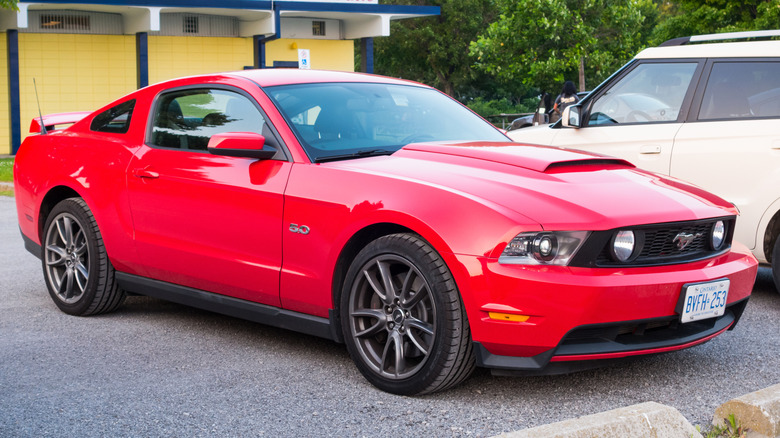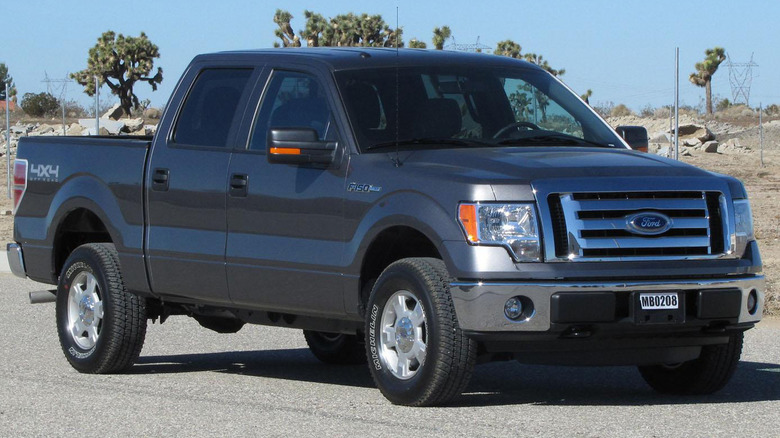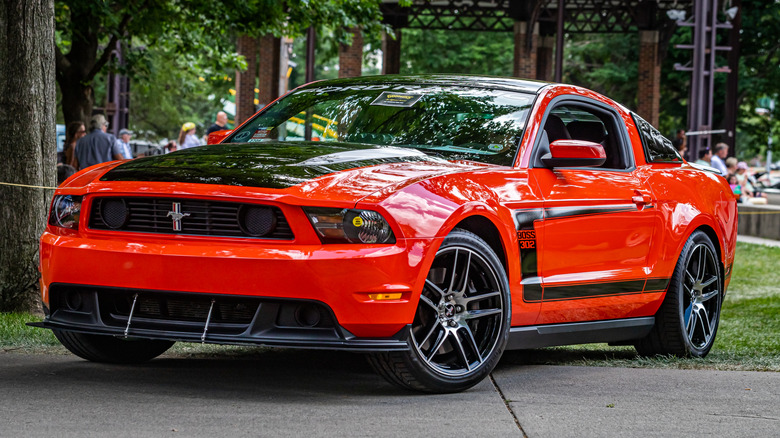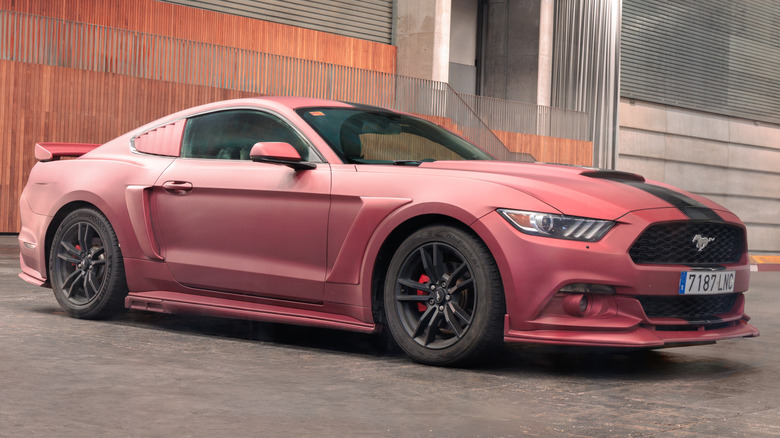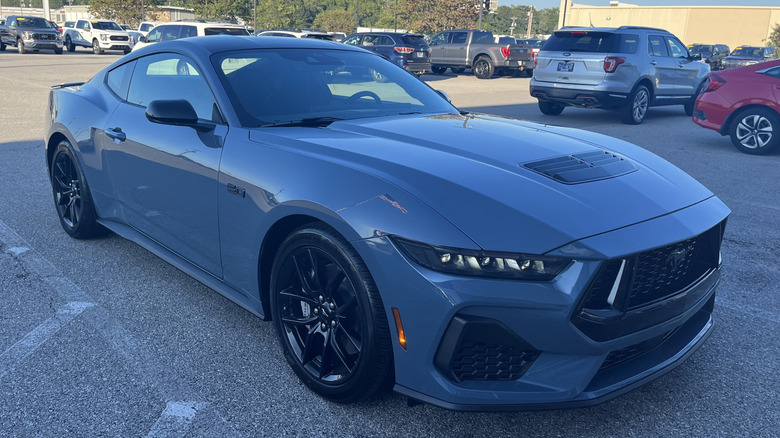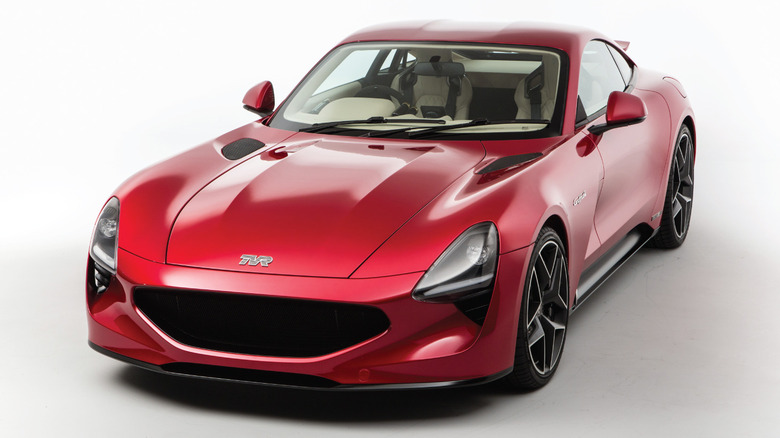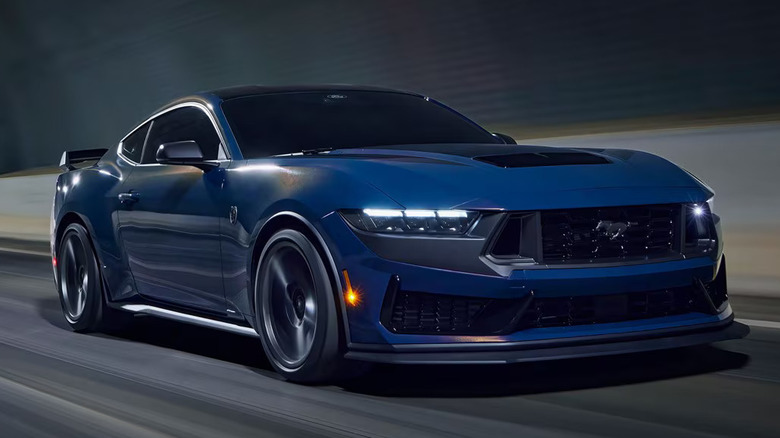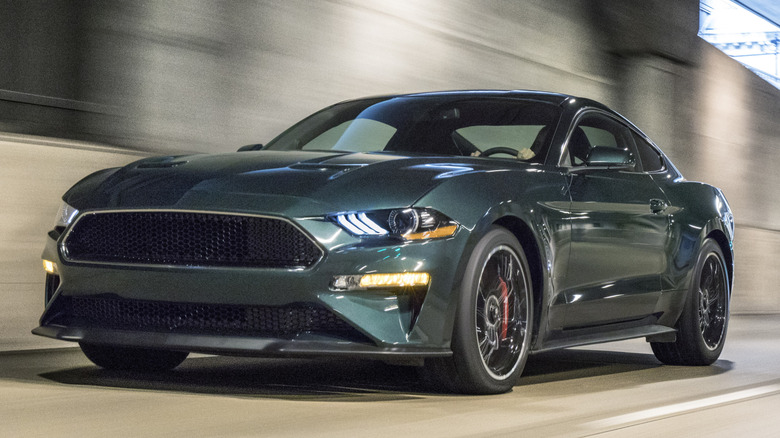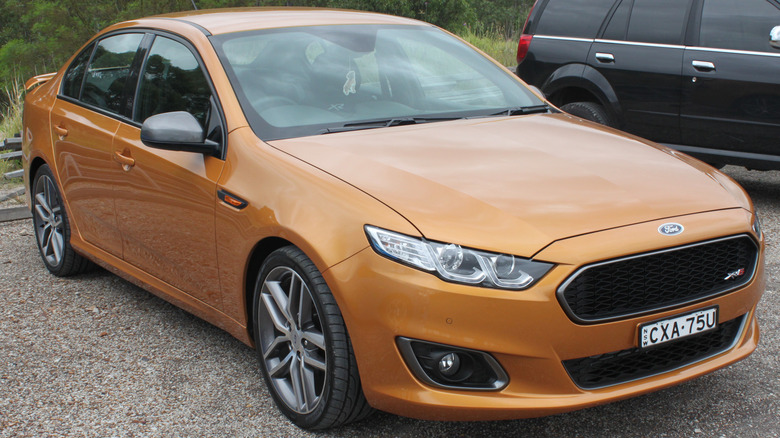Cars Powered By The Ford Coyote Engine
It all began in the 1980s when Ford wanted a new V8 engine that could compete with the growing pressures from Chevrolet and Dodge. Seven years and $4 billion later, Ford came up with a new modular single-overhead cam V8, which became the stepping stone for the Coyote engine. Ford developed the Coyote as a replacement for the Ford Windsor V8. Though its development started in 2010, it saw the light of day in 2011 when the Mustang GT and Ford F-150 became the first powered by the 5.0-liter DOHC Coyote V8 engine.
Why did Ford call it Coyote? It was a fitting tribute to legendary driver AJ Foyt, who drove the company's first four-valve V8 engine race car, nicknamed The Coyote, to a tremendous 25-victory run. Over the years, four generations of Coyote engines have been developed, and it is also sold as a crate engine that can be bought separately for classic car builds and restorations. While the Coyote V8 is considered a reliable and powerful engine, it still has its fair share of common problems. But with four generations out, Ford is not resting on its laurels with development, either.
The Ford Coyote engine is popular for third-party builds and restorations. A few notable models include the Ringbrothers Mercury Cougar, Icon Bronco BR, and several Velocity Restorations' modified classic vehicles. All thanks to the Coyote being a lightweight, compact, and powerful engine.
Ford Mustang GT S197 II (2011-14)
The Ford Mustang –- famously known as an iconic pony car – was such a hit that the first-generation Ford Mustang recorded over 22,000 bookings on the first day. With a history spanning six decades, the Mustang has undergone uninterrupted production across several generations. However, the 2011 model Ford Mustang — a facelifted version of the fifth generation — is quite iconic in itself. It not only got a new front fascia (smaller grille) and redesigned headlights, but it was the first Ford car to be fitted with the 5.0-liter Coyote V8 engine that revolutionized Mustangs to follow.
The new Coyote engine delivered low-end torque and power, reaching a redline of 7,000 rpm, which ensured enough grunt to feel the Mustang's muscle. Interestingly, the Ford Mustang GT S197 II got two versions of the first-generation Coyote engine. The 2011-12 Mustang GT models' Coyote engine produced 412 hp at 6,500 rpm and 390 lb-ft of torque at 4,250 rpm, whereas the 2013-14 Mustang GT, equipped with the Coyote V8 (1.5 generation), produced 420 hp at 6,500 rpm, with the same torque output as the previous generation.
The increase in horsepower was all thanks to some minor tweaks, including the removal of oil squirters, phosphorus-coated pistons, Boss 302 piston rings, and improved calibration. The Coyote V8 5.0-liter Gen 1 engine powered the 2011-2014 Mustang GT Base and Premium models, as well as the special edition 2011-2014 Mustang GT/California Special.
Ford F-150 (2011-present)
Ford – also known as the Blue Oval – powered the F-150 with the V8 Coyote engine in the same year (2011) as the Mustang GT. Ford has been producing the F-150 for over 75 years, and it is one of the most sought-after pickup trucks in America. It was stocked with a V8 Coyote engine replacing the 5.4L and 4.6L V8 engine trims offered for several years. The Coyote engine inside the 12th-generation Ford F-150 was a bit different compared to the one inside the Ford Mustang GT.
The engine power was lower than that of the Mustang's Coyote. The Coyote engine inside the Ford F-150 produced 360 hp at 5,500 rpm with 380 lb-ft of torque at 4,250 rpm, compared to 412/420 hp and 390 lb-ft of torque. One of the main differences between the Mustang and the F-150's Coyote engine was that the truck's engine uses a special intake design allowing for better low-end torque, suitable for towing and heavy lifting. Shorter intake camshaft duration also helped with increased torque at low end on the F-150.
The Gen 1 Coyote engine was used from 2011 to 2014, Gen 2 from 2015 to 2017 (385 hp and 487 lb-ft of torque), Gen 3 from 2018 to 2023 (395 hp and 400 lb-ft of torque), and Gen 4 from 2024 and onwards (400 hp with 410 lb-ft of torque). The introduction of the powerful Coyote engine inside the 12th-generation F-150 was also one of the reasons we picked it as one of the best F-150 generations of all time.
Ford Mustang Boss 302 S197 (2012-2013)
Recapturing the spirit of the original 1969 Boss 302 while continuing with the Mustang GT line, Ford launched the Mustang Boss 302. It was positioned above the GT and boasted a 5.0-liter V8 Coyote engine dubbed the Road Runner. The Boss 302 was manufactured from 2012 to 2013 and offered several upgrades over the GT, including improved suspension and aerodynamics. The interesting thing about this Ford Mustang Boss 302 was that it came with a naturally aspirated Coyote engine that produced 444 hp, up from the 412 hp offered by the GT.
It is touted to be the most powerful V8 engine ever put inside the Mustang. The increased power was partially due to improved CNC valves, a revised intake, and enhancements to the cylinder heads. Additionally, Ford tweaked the suspension and installed a bigger rear stabilizer bar, which differentiated it from the GT. The Boss 302 was carried over to 2013, the year in which the Mustang GT got an eight-horsepower boost, thanks to the Coyote (1.5 generation) engine.
There was also a limited-edition Laguna Seca Boss 302 specifically meant for tracks. It had no rear seats, a racing suspension, improved aerodynamics, and used a dedicated TracKey key (painted red) to switch between normal driving mode and race mode (via Motor Trend).
Ford Mustang S550 (2015-2023)
Another coincidence related to the Coyote engine and the Mustang was that after 2011, the 2015 Mustang S550 (sixth-generation Mustang) launched with the new 5.0-liter V8 Coyote Gen 2 engine. To expand its presence worldwide, Ford launched the Mustang S550 simultaneously in Michigan, Los Angeles, New York, Barcelona, Shanghai, and Sydney. The Mustang S550 was produced from 2015 to 2023, and it retained its muscle car DNA and turned into a beast of a car. At its core was the Coyote V8 5.0-liter engine with a new setup. Fun fact: To celebrate Mustang's 50th year in 2015, a special edition 1964 (a reference to the launch date of the first Mustang) was launched in Kona Blue and Wimbledon White.
The second-gen Coyote engine retained the DOHC and Ti-VCT (Twin Independent Variable Camshaft Timing) and introduced some traits of the Mustang Boss 302, such as large intake and exhaust valves, stiffer valve springs to better handle its redline, new and improved cylinder head castings, and redesigned pistons, among other changes.
The result of this change was that the Gen 2 Coyote V8 offered better performance in straight lines and around corners. The engine produced 435 hp at 6,500 rpm and 400 lb-ft of torque. The sixth-generation Mustang GT was also a part of the "Need for Speed Rivals" game in 2013 and the 2014 "Need For Speed" film. The Gen 3 Coyote was then used inside the 2018-2023 Mustang GT, producing a staggering 460 hp and 420 lb-ft of torque.
Ford Mustang S650 (2024-present)
Coming to the 2024 Mustang, dubbed the S650, Ford didn't hold back introducing new elements. The 2024 model got new interiors, a fresh upper grille design (which was inspired by the 1960s models), classic Mustang triple-bar tail lamps, and LED lights on the front. The GT was different from other trims, as it had a bigger front grille for better air intake along with new front vents, a brand-new front splitter, and a rear diffuser.
The most important thing was the new Gen 4 5.0-liter Coyote engine, which was also the most powerful naturally aspirated 5.0-liter engine ever on any GT. This new engine produced a staggering 480 hp and 415 lb-ft of torque with a redline of 7,500 rpm. Revised exhaust, dual air intake box, and dual-throttle bodies helped improve power and performance. The new tweaks to the engine ensured that there was minimal induction loss and better airflow through the vents.
Ford also included an Active Valve Performance Exhaust option for the Mustang GT, which boosted the horsepower and torque to 486 hp and 418 lb-ft, respectively. This engine was paired with the returning 10-speed automatic transmission, with a manual option carried over from the S550. The car offered fun and enough power to put a smile on your face and a dent in your pocket.
TVR Griffith (2024)
After producing a bunch of good cars, TVR filed for bankruptcy in 2006. The brand came back from the dead when it announced the launch of the Griffith in 2017. However, since then, the car has been just on paper but not in the flesh. TVR was expected to launch the Griffith last year, but there's no sign of it. Yes, the official website does say that if you'd like to order a new Griffith, you can make a £5,000 (roughly $6,765) deposit and get in line, but there's no clarity on when you'd get the order.
While there's no information on whether or not the TVR Griffith has entered production, it did make headlines for using the Ford Coyote 5.0-liter V8 engine. The engine is in its naturally aspirated form with a few tweaks by the guys at Cosworth. According to TVR, the engine comes with a custom clutch, flywheel, ECU, dry sump, and other tinkering. The company says that the Griffith, equipped with the Coyote engine, will achieve a 400 hp per ton power-to-weight ratio.
TVR also claims that the Griffith is capable of accelerating from 0 to 62 mph in under 4 seconds and reaching a top speed of 200 mph (approximately 322 kph). While the short-lived TVR Sagaris is arguably the brand's best car, the Griffith's looks are also eye-catching. For now, we can only hope that things get back on track for the new TVR Griffith, and hopefully, we get to see or even test ride one.
Ford Mustang S650 Dark Horse (2024-present)
Alongside the standard Ford Mustang GT S650 (seventh-generation) models, the company also launched a Dark Horse Mustang package. Apart from the dark interior and indigo blue stitching on the suede flat-bottomed steering wheel and across other elements such as seats, door panels, gear shifter, and center console, the Dark Horse Mustang also offered boosted performance. Compared to the 480 hp of the standard Coyote Mustang GT, the Ford Mustang Dark Horse edition produced 500 hp at 7,250 rpm and 418 lb-ft of torque.
This package includes piston rods taken from the Shelby GT500's 760 hp 5.2L Predator engine. The dual throttle bodies and intake, plus the front grille, help the Coyote breathe cool air more easily and boost performance. The Mustang Dark Horse edition also came equipped with an auxiliary engine oil cooler, a rear axle cooler, and a lightweight radiator with powerful fans for impressive track performance. It offered a 10-speed automatic and a Tremec six-speed manual transmission.
Sporty paddle shifters helped with faster shifting, and the drive mode button was easily accessible with the driver's thumb. While the Mustang GT was available as a coupe or convertible, the Dark Horse Mustang was only available as a hardtop coupe. Also, the standard Mustang GT was available in 12 colors, whereas the Dark Horse was offered only in Blue Ember. With so many differences between the Mustang GT and Dark Horse Mustang, the latter was the obvious choice for those looking for that extra grunt. The 2025 Mustang Dark Horse features a Gen 4 Coyote engine with new hood graphics, a 13.2-inch infotainment screen, and other upgrades.
Ford Mustang S550 Bullitt and Mach 1 (2019-2023)
Classic muscle cars were not only about power; They were famous for who used them. The 1968 Ford Mustang GT is more iconic than most muscle cars because it was what Hollywood legend Steve McQueen drove in the movie "Bullitt." The car was also involved in arguably the greatest car chase scene ever filmed. Ford produced the Bullitt Mustang as a promotional vehicle, which turned out to be so phenomenal that many might have forgotten about the movie, but not the car.
Ford brought back the iconic vehicle, or specifically the nameplate, with the fifth-generation Mustang. The 2019 model highlighted all aspects of the original Bullitt, featuring fastback styling, a honeycomb grille, a Bullitt emblem faux gas cap, quad-rear exhaust, no spoiler, and no pony emblem, among other homages to the 1968 Bullitt. It was equipped with the Gen 3 Coyote engine, which was engineered to produce 475 hp and 420 lb-ft of torque and topped out at 163 mph (roughly 262 kph).
Closing out the fifth-generation Mustang was the Mach 1, launched in 2021, which got several components from the Shelby. Ford Authority considered it the "most track-capable 5.0L Mustang" they've ever built. The Mach 1 also got the same Gen 3 Coyote engine and the same engine performance as the Bullitt. However, later models cut off the performance by 10 hp, bringing it down, thanks to strict emission norms. A total of around 800,000 units of the S550 Mustangs were produced globally by Ford, also making it one of the popular generations of Mustangs.
Ford Falcon FPV Australian (2011-2016)
The Australian Ford Falcon FG-X was powered by the Ford Coyote engine outside the U.S. and Europe. It was equipped with the U.S.-developed Coyote 5.0-liter V8 engine, which replaced the 5.4-liter Boss engine due to emission norms. The Coyote supercharged engine, known as the Miami engine, inside the Australian Ford Falcon produced 335 kW of power and 570 Nm of torque, which is equivalent to 450 hp and 420 lb-ft of torque. The Australian Ford Falcon FG-X was produced from 2014 to 2016, when Ford ceased production in the country.
ProDrive produced the Miami V8 engine through a $36 million program that ran in parallel with the development of the Ford Coyote engine. All components of the Miami engine were locally sourced and were assembled in FPV Australia's factory in Campbellfield, Victoria. The Ford Falcon FG-X (also known as the XR8) was available with either a six-speed automatic or six-speed manual transmission. Aside from this, the Falcon featured 19-inch alloy wheels, all-wheel Brembo disc brakes, leather interiors, an 8-inch infotainment system with voice command, radio, GPS, dual-zone climate control, and other standard features.
However, before the FG-X received the Coyote engine, the FPV (Ford Performance Vehicle) division of Australia fitted the Coyote V8 inside the Falcon FG models. The Miami V8 engine was also found inside the FPV Falcon GT, with the Ford Falcon FG-X, the seventh-generation Falcon in Australia, being the last model to feature the Coyote-based engine.
